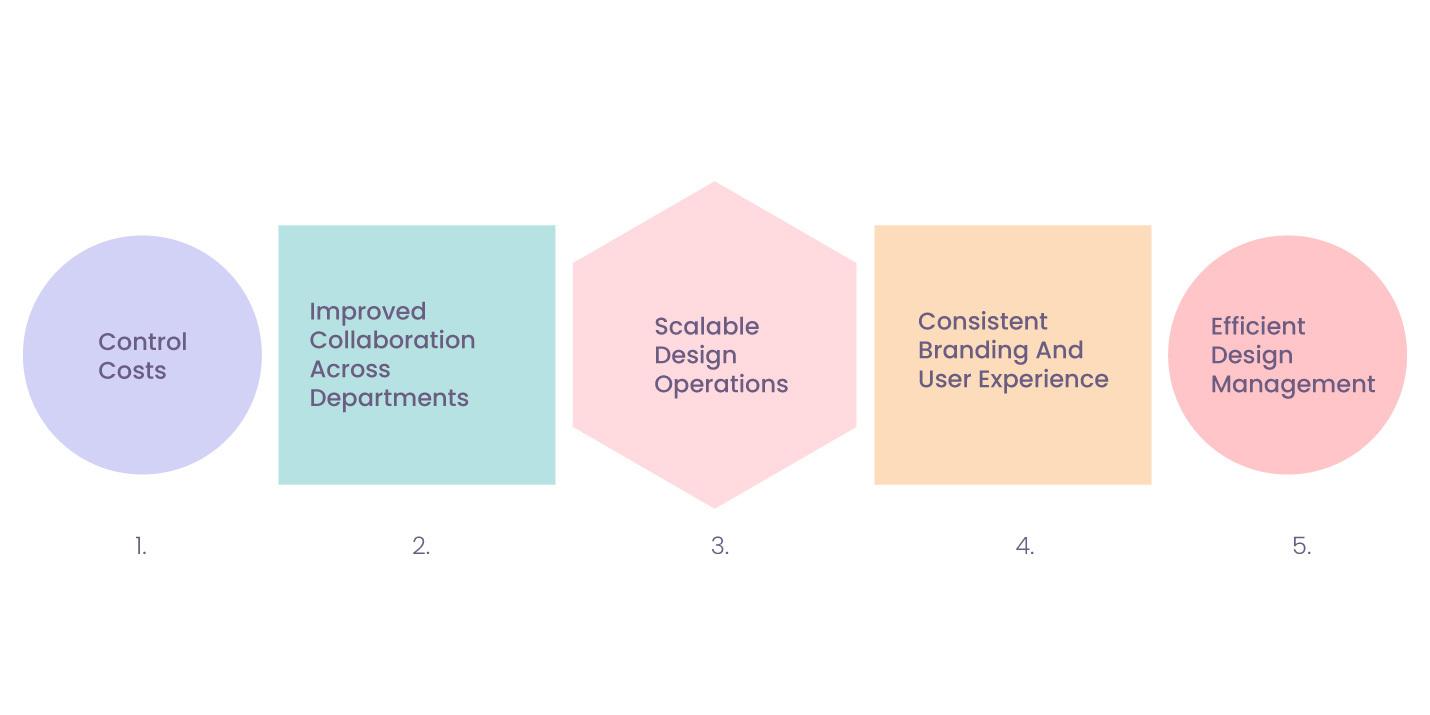5 Reasons Every Scaling Team Should Invest In DesignOps

Product teams and design teams both have interdependent relationships with each other. When the product team sees an increase in demand and needs to scale up, the design team needs to do the same to be able to cater to the increase in design functions as well.
However, without proper planning and the right tools, scaling teams often find themselves plagued by a variety of problems, ranging from communication gaps to inefficient workflows.
The most efficient way to overcome these issues is to implement DesignOps. Let’s take a look at the top 5 reasons every scaling team will benefit from investing in DesignOps.
Challenges faced by growing design teams
Let’s begin by listing the challenges growing design teams are most likely to face.
-
Broken design workflows
-
Communication gaps
-
Inconsistent design
-
Legacy systems that don’t scale
-
Rising costs
Here’s a more detailed look at each of these challenges.

1. Broken design workflows
When design teams are smaller, each designer has the freedom of choosing the tools they’re most comfortable working with and creating workflows that suit their pace.
However, as teams grow, this practice can lead to inconsistencies because of different resources using different tools. It also leads to fractured design workflows, affecting overall design output as well.
2. Communication gaps
Teams are no longer required to be local. This means when a design team grows, the best designers from around the world could be a part of it.
While this gives the team the creme-de-la-creme in terms of talent, geographical locations and differences in time zones often make communication and collaboration challenging.
3. Inconsistent design
Smaller design teams afford designers the freedom of being flexible with design processes. However, as design teams grow, not having design processes set in stone will lead to different designers approaching the same project with different processes.
These inconsistencies are bound to lead to inconsistencies in design output, negatively affecting the quality of the entire project.
4. Legacy systems that don’t scale
A lot of design teams often find themselves at an impasse when it comes to scaling because of technology.
They find that the platforms and tools that they have used so far have been great at serving their design team’s needs, but are incapable of servicing the needs of a larger, faster, and busier design team.
The only solution is often to ditch these legacy systems and overhaul the entire tech roster for the design team with more scalable and intuitive design tools.
5. Rising costs
Without well-defined processes and standardized tools to use, scaling design teams are likely to find a lot of inconsistencies in their projects.
Fixing these errors and inconsistencies will cost the team a lot of extra time that could have been spent on newer productive projects. This extra time spent is sure to increase the overall costs of the project as well.
5 reasons to invest in DesignOps as a growing team
DesignOps can help scaling design teams address these challenges. Here are some of the DesignOps features that are sure to help growing teams.
1. Efficient design management
2. Improved collaboration across departments
3. Consistent branding and user experience
4. Scalable design operations
5. Control costs
Here’s a detailed look at how DesignOps benefits growing teams.

1. Effective design management
DesignOps makes it easy to manage design workflows.
DesignOps allows design teams to unify multiple design workflows from different platforms to create a unified workflow.
Resource allocation is easier with DesignOps since it offers greater visibility into the engagement of each resource.
By creating a repository of knowledge, processes, and workflows, DesignOps makes it easy for resources to stay on track, refer to best practices, and when applicable, even reuse workflows.
This not only makes design management easier but also helps make the entire design process more consistent.
2. Improved collaboration across departments
DesignOps gives all the stakeholders in a project visibility of where the project stands, and what each resource involved in the project is doing. These stakeholders include other members of the design team, the product team, and the operations team.
This function is especially useful for scaling teams that have team members located in different locations and time zones.
With the clarity that DesignOps brings, communication and collaboration between stakeholders become more efficient and effective.
3. Consistent branding and user experience
DesignOps helps standardize the tools used, reducing tool fatigue. It also helps create a knowledge bank and repository of best practices, and workflows and helps standardize processes.
The result is better design maturity, more consistent branding, and improved UX.
4. Scalable design operations
DesignOps helps streamline every aspect of the design process, including collaborations and communication both internally within the design team and with other stakeholders, new resource onboarding, training, resource allocation, and more.
All of this enables design teams to scale up and still maintain high-quality standards.
5. Control costs
Standardization of processes and tools, easier onboarding, effective training, transparent progress tracking, and improved communications all contribute towards ensuring the costs of executing projects are controlled.
As a result, the team can allocate funds toward other avenues, such as upgrading infrastructure and tool stacks.
Implement DesignOps and scale your team with Cubyts
If your team is scaling and your future vision is to offer your market world-class design-led products, then Cubyts is the perfect DesignOps platform for you.
Cubyts enables seamless collaborations between design and product stakeholders using our integrations with Jira and Figma. Our platform will help you define best practices, predict design outcomes more accurately, manage deadlines and ensure your design goals enable the maximum ROI.
Try Cubyts for free today and discover these and other amazing features that make Cubyts the ideal DesignOps platform for growing teams.
